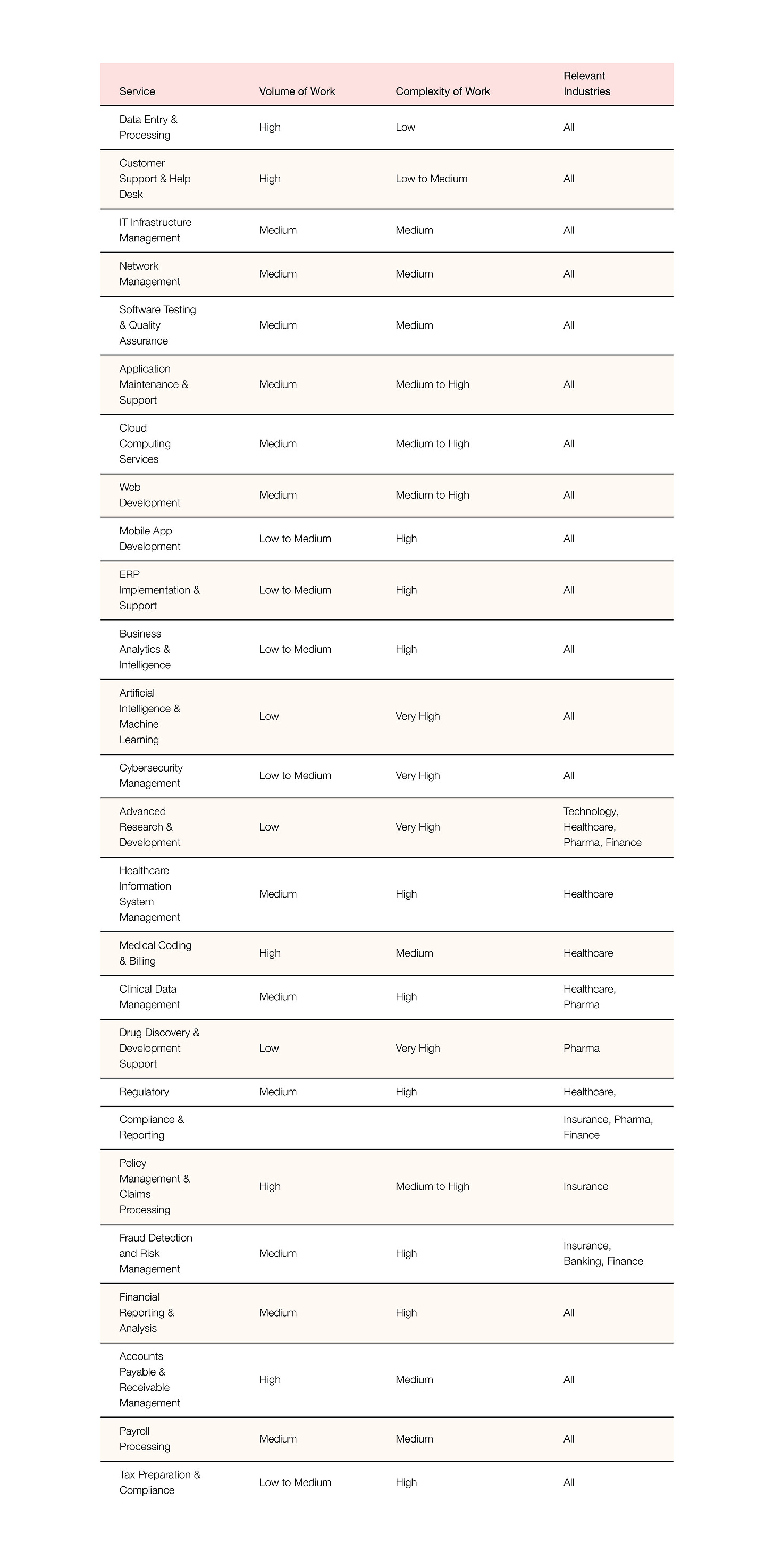Why generative AI is critical to IT/outsourced services
2022 and 2023 have witnessed a Cambrian explosion of generative AI technologies, tools, and enterprise and consumer use cases. Today, there’s no question that generative AI tools and technologies can mimic humans in the creation of text, code, numbers, images, audio, and sometime soon, video in powerful and context specific ways. It’s therefore no surprise that we will see a disruption of the IT services industry, which relies on these capabilities – context specific analysis and generation of text/code/numbers, images, audio, and video. This thesis examines the near term ways in which these industries will transform and opportunities for new startups in the space. We believe this is a generational tailwind. A McKinsey report estimates that IT services and customer operations will see productivity gains to the tune of close to $1T annually over the coming years.


Immediacy of disruptions
The IT/outsourced services industry’s scope ranges from outsourced use cases like contact centers, app development/QA to the discovery of new molecules for pharma companies. To understand where we are likely to see near term disruption and the creation of new startups, we have divided the outsourced use cases along the axes of complexity of service and volume of work.

- High Volume of Work: These services often require a significant amount of manual intervention or repeated tasks.
- Medium Volume of Work: These services require a balanced approach, blending automated systems and manual oversight.
- Low Volume of Work: These are usually specialized tasks that need a high level of expertise and are often not needed in large volumes.
- Low Complexity of Work: The tasks are generally repetitive and require little to no specialized skills.
- Medium Complexity of Work: These tasks require some level of technical expertise or understanding of specific domains.
- High Complexity of Work: These involve specialized knowledge, often needing advanced technical skills.
- Very High Complexity of Work: These tasks are at the forefront of technology, requiring deep expertise and significant experience.
Through interviews with large service providers, startups, and primary/secondary research, we have zeroed in on the following views about opportunities for incumbents and startups.
Our views
Large incumbents will continue to emerge as winners in the high volume, low complexity segments
Large IT services companies have announced large investments in upskilling and capability building for generative AI. All the IT service majors we spoke to have started building in-house teams for code and test case generation, content and digital marketing automation, text and speech generation for contact centers, and analytics automation. It’s still early for these initiatives to show impact and most of what’s happened so far has been pilot level work for marquee customers and partnerships with the largest cloud and AI infra providers, but, we expect progress to be fast. The biggest near term change will be gains in internal efficiency leading to lower cost for customers. Full/large scale human replacement will only happen, in the near term, in the lowest complexity use cases like contact centers. With globally high inflation and interest rates, the consensus among customers of IT services that we spoke to, is that generative AI creates an opportunity for them to renegotiate costs with the suppliers of services.
The near term opportunity and value pools for startups are highest in the medium complexity and medium to high volume segments
We believe verticals like data analytics, marketing services, accounting and reporting services, IT vulnerability and penetration testing, are ideally suited for startups to build in. These verticals require innovation beyond the off the shelf foundational models and don’t require large teams to build the core modules that will get used for the service delivery. Also, while independently large, these verticals are not larger than the high volume, low complexity verticals that are the largest revenue contributors for the large incumbents. Also, we found that these verticals are underserved compared to market need, by the large incumbents.
There’s an opportunity for startups to partner and enable large incumbents in the high complexity segments
Even with high complexity segments like healthcare, there are pockets of work which are low complexity, like insurance claims processing, population health analytics, etc. There’s an opportunity for startups to build solutions for these areas of work and partner with the large incumbent healthcare IT services providers. We see similar opportunities in all high complexity segments – healthcare, strategy consulting, design, real estate, etc.
Secondly, startups are ideally placed to provide core technology and infrastructure that allows the large incumbents to transform.
The rise of AI augmented managed labor marketplaces
Another trend we have been noticing (and backed) at Lightspeed is the rise of AI augmented managed labor marketplaces. We have written about how companies want to be able to change their teams easily. One way to do this is with outsourcing, but this usually involves long-term fixed contracts. AI trained suppliers of service on these managed marketplaces (like Pepper for marketing content or Gushwork for multiple outsourced services, leads to greater NPS through faster turnaround times and high quality outputs. As we have maintained before, the goal shouldn’t be to win just through lower pricing.
What startups should keep in mind
New business models can now emerge
For non contact center use cases, most services companies charge their customers for time and the number of people assigned to a project. Growing efficiencies will lead to lower use of people and greater use of compute resources. There’s an opportunity for services companies to start billing on outcomes and compute. This change will most likely be driven by startups and is likely to be well received by their customers because of greater transparency upfront on project costs and lower costs overall.
GTM for IT services and BPM companies in the new era will still largely look the same
We don’t believe there are going to be major changes in how services companies go to market and sell. The playbooks that have worked so far will continue to work. Startups would do well to build these capabilities early using experienced hands from the large incumbents.
Low error tolerance industries will take time to warm up to generative AI
In our interviews, we repeatedly heard concerns around bias and hallucinations in generative AI technologies, from leaders of companies that require low error tolerance in the services that they outsource, like medical coding and remote physician assistance. Startups starting out in these spaces will need to be ready for multiple evolutions in technology and the long journey of building trust.
Conclusion
Generative AI is changing the IT services industry, creating new opportunities for both established companies and startups. Larger companies are likely to take the lead in areas that require high volumes of simple tasks, while startups can find success in areas with medium complexity and volume. Also, as AI increases efficiency, businesses can start charging based on results rather than time and manpower, a change startups are well-positioned to drive. However, the way companies approach and enter the market shouldn’t drastically change, even with AI advancements. In essence, this AI shift is a major opportunity for both existing companies and startups to evolve and grow.
As this transformation unfolds, India holds a unique position as a nursery for budding startups in this domain. With its robust IT infrastructure, vast pool of tech-savvy talent, and a proven track record in IT services, the country offers the perfect environment for nurturing innovation in AI-driven services. The intersection of these assets with a vibrant startup culture could make India a global hotbed for pioneering companies in the generative AI space.
As we have said, this time is different and the time is now!
Authors



